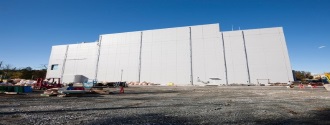A facility for incinerating miscellaneous solid low-level waste has begun operating at the damaged Fukushima Daiichi nuclear power plant in Japan.
The incinerator will be used for disposing of items such as used protective clothing and construction waste.
Fukushima Daiichi solid waste incinerator – 460 (Tepco)
The miscellaneous solid waste incineration facility houses two incineration lines, each comprising a rotary kiln incineration system and a series of exhaust filters. The two lines share a common exhaust stack. Ash generated in the incinerators is stored in sealed drums for final disposal. Each incineration line has the capacity to process 300 kilograms of waste per hour. The facility can operate around the clock.
Construction of the facility began in May 2013 and was completed last November. It was built by Kobelco, part of Kobe Steel Group, under contract from Tokyo Electric Power Company (Tepco). Cold testing of the facility – in which non-contaminated waste was burned – was carried out between 25 November and the end of December. This was followed last month by hot testing – in which actual contaminated waste was incinerated.
Tepco announced today that the facility had now started full operation.
It is designed to burn solid wastes such as used personal protective equipment (including gloves and overalls), construction materials (rags, wood, packing materials, paper, etc), as well as waste oil and spent resins.
Tepco said, “The waste materials can’t be taken off the site, so incinerating it and then storing the ash in sealed containers has been found to be the safest and most efficient way to reduce its volume.” It noted that the facility was fitted with filters to prevent the dispersal of radioactivity in the air. “The amount of radioactive materials in the exhaust gas will be measured on a regular basis to prevent any impact on the surrounding environment,” the company said.
The facility is intended to reduce the volume of the radioactive waste “to one several tenth or less”, Tepco said.
Three existing low-level waste incinerators on the Fukushima Daiichi site – with a combined capacity of handling over eight tonnes of waste per day – are not in operation as they are now being used to store and process radioactive water instead.








































